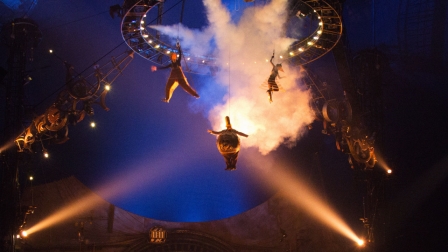Leadership Lessons From A 25-Year Career In Experimental Theater
I spent 25 years in experimental theater. I wrote, directed, produced, taught, and performed shows ranging from a 12-hour performance piece to a highly narrative homage to the golden age of television. I even dabbled in circus acrobatics. In the process, I learned a lot about building a cast and crew that fits the project at hand.
Here’s how my time in the theater shaped my approach to hiring, staffing, and leading teams of designers, web developers, and producers at a brand engagement agency today.
1. Hold Auditions
In theater, you audition performers to find the right fit for the role. To make the right choice, you need to put them in a context that lets them show off what they can do: an improvisation, a scene, a monologue. This way you get the chance not only to validate their technical skills but also to see how they take direction and collaborate.
In the business world, though, we often interview people mainly based on their resumes: a rehash of what the person has already done, plus some discussion geared to judging “cultural fit.” After nearly three decades of evaluating potential on stage and in business, I treat interviews like auditions; what’s on someone’s resume is far less important than the potential they demonstrate.
So while you learn a lot by asking about prior work—it can show you a candidate’s passions and thought process—it doesn’t show the person in action. I recently interviewed a candidate for a UX role. After a good initial conversation, I asked him to respond to a brief for now-completed work. The goal of the assignment I set was to see if he understood the emotional context of the brand, not just the functional needs that were inherent in the task. I didn’t need to verify if he could make a wireframe; it was about whether he could think conceptually. He could—and passed the audition.
Sometimes, though, the work misses the mark. For years I have worked with people who are honing their craft, which requires them to show some of the vulnerability that accompanies creative expression. As a result, I’ve come to feel strongly about offering feedback. Putting something out there warrants the respect of explaining what went wrong.
2. Hire Like A Casting Director
Each project demands a specific cast, and I do my best to assemble the right mix of talents. To assess team members’ personalities, skills, and working styles, I tend to draw on the theatrical archetypes casting directors use to find the right balance of characters for a strong performance—both onstage and off:
- Strategists are the directors, understanding the greater story and guiding the team toward a cohesive performance.
- UX experts, designers, and developers express the story visually and through code, becoming the storytellers who bring the work to life.
- Business analysts and quality-assurance specialists are the set and lighting technicians, making sure all of the pieces come together in the right way.
- And of course the producers are, well, the producers—keeping the show moving and everyone happy.
It’s the harried nature of client-based business to see staff as resources that can be readily moved around to plug holes. But my experience in theater has proven a good antidote to that mind-set.
In theater, you cast people due to a combination of practicality (“I know how to trapeze, so auditioning for another circus performance makes sense”) and passion (“I’m accomplished in absurdist theater but would like to try my hand at a solo show”). I like to offer my teams the opportunity to think beyond their established talents and to try something new—to take the next logical step, whatever that might be for them.
3. Brush Up On Your Castmates’ Parts
While my current role stretches across strategy, creative work, and producing, in theater terms I’m probably most similar to an executive producer, making sure we’re delivering on the purpose. But like most leaders, I play multiple roles. Some days, I’m the casting director, spending more time on building the team. Other days, I’m the director, shepherding everyone along to bring the playwright’s vision to life. And sometimes I’m a stagehand, mopping up before the show.
Every day, though, I’m also the understudy: In every project, the proverbial show must go on—which means leaders need to know where everything stands, what’s needed to get the work done right, and how to do that if someone leaves abruptly.
What I learned in theater has a profound impact on my approach to more than just hiring and staffing, though. It informs how I view the very nature of our work. I’ve spent years figuring out how to get the best out of people with different agendas, skills, and backgrounds in the high-stakes world of performance. Today, that experience pushes me to try and understand others’ points of view, and even to translate what one team member is saying in a way that someone else will understand.
In the best theater, like in business, the ensemble is what really matters, not the star. And it’s a leader’s job to get the whole cast and crew pulling in the same direction, one show after the next.
Peter Petralia is managing director of digital strategy for brand engagement firm Sullivan, where he leads all digital efforts for the firm. An agency veteran, Peter has worked across industries on global initiatives for some of the world’s most admired brands. He also used to be in the circus.
Fast Company , Read Full Story
(21)


